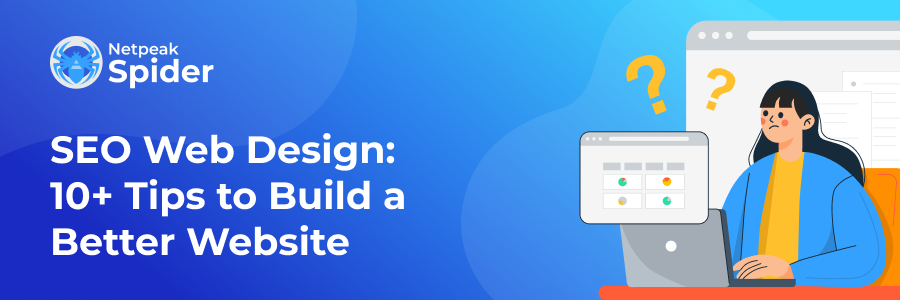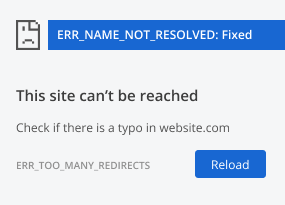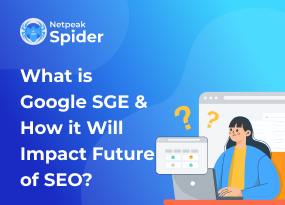10+ SEO website design tips to implement right now
Site Audit Issues
Have you ever thought that website design and SEO are completely different things? No way! You can combine both SEO and user-friendly web design to create the best website experience for your users and, at the same time, don’t lose on your rankings. Let’s see how to do this.
What Is SEO Web Design?
SEO website design is a set of techniques that focus on creating both SEO-optimized and user-friendly websites. Since most of the user experience rankings, such as website speed and mobile responsiveness, influence SEO, you need to ensure that there is no weak point in your website optimization strategy.
In simple words, SEO web design is all about creating user-friendly websites that are indexable by search crawlers.
Why does SEO for web designers matter? First of all, websites that are SEO-optimized get more traffic. It doesn't mean that you shouldn’t optimize your website for users. Create websites with users in mind, but don’t neglect SEO. SEO web design is all about combining both and getting better results.
9 Ways to Ensure SEO-Friendly Web Design
Let’s discover the best practices that will help you create website design with SEO in mind.
Mobile-First Design
Mobile-first indexing has been with us for a long time, and it’s here to stay. Google uses the mobile version of a website as a primary one and crawls it with the smartphone agent. Here are the major tips for creating a mobile-first website:
- Keep the visual hierarchy of your content with the users in mind.
Make sure that your content is easy to digest on mobile. Place the most important elements in front of the user and ensure they are easy to find on mobile. Also, check if nothing distracts the user from your content and remove any intrusive pop-ups.
- Make your design responsive and optimize your images.
With responsive design, HTML code and URLs stay the same for all devices, but the layout changes depending on device specifications. Don’t forget to use white space; it makes the layout less cluttered and more readable.
Website Speed
Aim for the page load time between 0-3 seconds. If your website loads longer than 3 seconds, you risk losing your visitors. Website speed depends on different factors, such as response times of server/hosting, file size, and network connections.
You can use tools like Pingdom Website Speed Test, GTmetrix, and Google PageSpeed to test your website’s page speed. Usually, they also provide recommendations on how to improve your website’s speed.
Website Structure
Website structure defines how pages on your website are organized.
If your website is well organized, it’s easier for search engines to find and crawl it. Also, it improves your internal linking strategy and helps website users find what they need. Here’s what you need to do to improve your website’s architecture:
- Unite similar content in groups
- Organize these groups in a logical hierarchy
- Make sure users can find any page on your website with less than four clicks
Indexability and Crawlability
If you want search engines to effectively crawl and index your content, you need to improve your indexability and crawlability. Here is how to ensure search engine optimization website design.
- Create an XML Sitemap
Create and submit an XML sitemap to search engines (Google, Bing, etc.). This file provides a list of all your website's URLs, helping search engines understand the structure and content of your website.
- Сheck out Robots.txt File
Ensure that your robots.txt file is configured correctly. This file instructs search engine crawlers which parts of your website to crawl and which ones to avoid. Make sure it allows access to essential content and pages.
- URL Structure
Use clean and SEO-friendly URLs. A well-structured URL provides both users and search engines with clear information about the content of a page.
- Canonical Tags
Implement canonical tags to avoid duplicate content issues. This helps search engines understand the preferred version of a page when there are multiple URLs with similar content.
Navigation and Internal Links
Clear and intuitive navigation menus help users easily find the information they are looking for. Well-organized navigation enhances the overall user experience and encourages visitors to explore more pages on your website. Make sure that all the content on your website is discoverable, and use internal links to increase the time spent on your website.
Page Design and Usability
User experience is an ongoing process, so don’t neglect user feedback and analytics as it provides valuable insights into areas that may need improvement. Additionally, usability testing with real users can help identify specific pain points and areas for enhancement in your website's design and functionality.
Accessibility
Nowadays, digital inclusion is a must-have. Here’s how to implement it:
- Include descriptive alternative text (alt text) for all images on your website. Alt text serves as a textual description of images, providing context for users who may use screen readers or have images disabled. Ensure the alt text accurately conveys the content and purpose of the image.
- Make sure all interactive elements and navigation can be accessed and operated using a keyboard alone. Some users, particularly those with motor disabilities, rely on keyboard navigation.
- Include captions for videos and transcripts for audio content. This is essential for users who are deaf or hard of hearing and those who may prefer to consume content in a text format. Captions should be synchronized with the video, and transcripts should be easily accessible for audio content.
Schema Markup
Schema markup helps search engines understand the content on your website. Moreover, schema markup enables the creation of rich snippets, which are enhanced search results displayed on search engine results pages (SERPs). Rich snippets provide additional information about your content, such as reviews, ratings, prices, event dates, and more. This enhanced presentation can increase visibility, click-through rates, and overall engagement.
Images
If you optimize your images in the right way, you’ll get better page load time, reduce your bandwidth usage, and improve your user experience.
- Choose the right image format.
Use the appropriate image format for your content. JPEG is ideal for photographs and images with many colors, while PNG is suitable for images with transparency or simpler graphics. WebP is a newer format that offers high quality with smaller file sizes.
- Resize images to the actual dimensions needed on your website.
Don't upload larger images and rely on HTML or CSS to resize them. This reduces the file size and improves loading times.
- Compress images.
Use image compression tools to reduce the file size without compromising too much on quality. There are various online tools and image editors that allow you to compress images effectively. Popular ones include TinyPNG, JPEGoptim, and ImageOptim.
- Configure your server to enable browser caching.
This allows users to store images locally after the initial visit, reducing load times for subsequent visits.
How SEO-Friendly Web Design Can Help Your Business
An SEO-friendly website created for users is your recipe for improving your online business. Here’s why it’s important to combine both user experience and web design for SEO.
Boosting Your Visibility
As we have already mentioned, if your website is filled with useful information but is not indexed, you do not exist. That’s why you need to optimize your website, regularly maintain it, and fix any issues.
Future-Proofing Your Website
Your SEO strategy is the pillar of your website, which defines its future. Regular website maintenance is your investment in the website and the results it will bring you over time.
Making a Good Impression
Your website is your business card. Just being present in the search engine results is not enough. You need to create a first impression by optimizing your website and making it easy to navigate.
How to Conduct a Website Audit with Netpeak Spider
Here is how to conduct a website audit with this tool in just a few minutes.
- PageRank Calculator
Quickly check your page's internal linking, link weight distribution, and linking strategy, and explore what pages burn incoming link equity and which ones don't get any.
- Source code checkup
No need to open a page in a browser anymore. With Netpeak Spider you can check any link's HTTP request and response headers, redirects, and all the extracted text with no HTML code.
- Sitemap generation
Easily generate XML, HTML, or image sitemaps after crawling your website. In addition, you can scan your existing sitemap for any errors.
- Various types of reports on multiple domains
Crawl multiple URLs and get a detailed SEO audit report in one convenient table.
Want to try Netpeak Spider? Create a free account and start crawling to get results in a few clicks!
Conclusion
SEO website design doesn’t mean that you should create a website for crawling robots, stuff it with keywords, and call it a day. First of all, you need to understand your users and create a website that meets their needs. And, if you combine it with the best SEO practices, you double down on your success.


.png)
